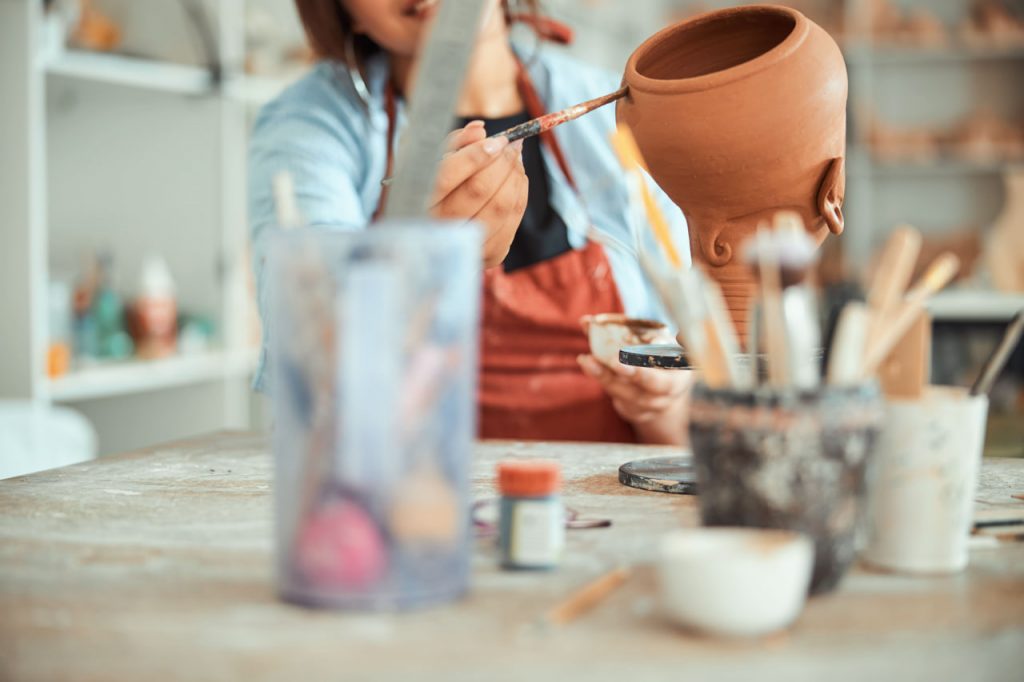Glazing is one of the most exciting aspects of pottery. It transforms a simple clay piece into a finished work of art, adding color, texture, and protection. Whether you’re new to ceramics or an experienced potter, understanding different glazing techniques can help you create breathtaking effects that make your pottery stand out.
Understanding Glaze: More Than Just Color
A glaze is a liquid suspension of minerals, oxides, and silica that, when fired at high temperatures, forms a glass-like coating on pottery. Beyond just aesthetic appeal, glazes serve several important functions:
- Enhancing Beauty – Glazes bring out colors, textures, and surface effects that would otherwise remain dull.
- Protecting the Clay Body – A properly fired glaze seals the pottery, making it water-resistant and more durable.
- Improving Functionality – Food-safe glazes allow pottery to be used for eating and drinking without absorbing liquids.
Glazes come in various types, including glossy, matte, satin, transparent, opaque, and reactive finishes, each offering unique visual and tactile qualities.
Popular Glazing Techniques for Stunning Effects
Glazing is an art form in itself, with multiple techniques to achieve different textures, color combinations, and finishes. Here are some of the most popular methods used by potters around the world:
1. Dipping: The Classic Method
Dipping pottery into a bucket of glaze ensures an even and consistent coating. It’s ideal for production pottery, where uniformity is essential. However, timing is crucial—too long in the glaze, and the layer may be too thick; too short, and coverage may be uneven.
Pro Tip: Experiment with multiple dips to create color variations and depth in your glaze.
2. Brushing: For Precision and Detail
Brushing allows for greater control over glaze application, making it perfect for adding layers of different colors, hand-painted details, or textural effects. Using soft, wide brushes, potters can create expressive strokes or blended transitions between colors.
Pro Tip: Apply at least three even coats for solid coverage, allowing each layer to dry before applying the next.
3. Pouring: A Natural Flow of Color
Pouring glaze over pottery creates organic, flowing effects with beautiful drips and streaks. This technique is especially effective for larger pieces that may be difficult to dip into a glaze bucket.
Pro Tip: Tilt the piece as you pour to control the direction of the glaze and achieve artistic patterns.
4. Spraying: Soft Gradients and Layered Depth
Using a spray gun or airbrush, glazes can be applied in fine layers, allowing for seamless blending and smooth, gradient effects. Spraying is often used for delicate color transitions and large-scale pottery.
Pro Tip: Keep the spray nozzle moving in a circular motion to avoid uneven spots or pooling.
5. Wax Resist: Creating Un-glazed Designs
Wax resist is applied to areas where you want to prevent glaze from sticking. Once fired, these sections remain raw and textured, adding contrast and design elements to your pottery. This technique is widely used for two-tone finishes and decorative patterns.
Pro Tip: Combine wax resist with brushing or dipping for intricate, layered effects.
6. Layering Glazes: Experimenting with Depth
Combining different glazes in layers can result in unique effects, as some glazes interact with each other in unpredictable ways. Certain glazes break over textures, highlight raised patterns, or create speckled, dripped, or marbled finishes.
Pro Tip: Always test layered glazes on sample tiles before applying them to your final piece to see how they interact at different firing temperatures.
7. Raku Firing: Crackles and Metallic Finishes
Raku is an exciting low-fire glazing technique where pottery is removed from the kiln while still hot and placed in a reduction chamber (such as a metal container with combustible materials like sawdust or newspaper). This rapid cooling process creates striking crackled textures, unpredictable glaze patterns, and metallic or smoky finishes.
Pro Tip: Use glazes formulated for raku firing to achieve the best effects and avoid thermal shock damage.
Understanding the Role of Firing in Glazing
The magic of glazing happens in the kiln. Different firing temperatures produce different results, and the glaze’s chemistry changes depending on heat and oxygen levels in the kiln.
- Low-Fire (Cone 06–04, ~1,820°F–1,940°F / ~995°C–1,060°C) – Produces bright, colorful, and glossy finishes but may be less durable.
- Mid-Fire (Cone 5–6, ~2,167°F–2,192°F / ~1,186°C–1,200°C) – A great balance of durability and color vibrancy, often used for functional pottery.
- High-Fire (Cone 9–10, ~2,300°F–2,380°F / ~1,260°C–1,305°C) – Creates earthy, natural finishes with subtle glaze variations, often seen in stoneware and porcelain.
The atmosphere inside the kiln also plays a crucial role. Oxidation firing (more oxygen) produces bright, clean colors, while reduction firing (less oxygen) enhances deep, muted, and reactive glaze effects.
Tips for Perfecting Your Glazing Skills
- Always Test First – Use sample tiles to see how a glaze reacts before applying it to your final piece.
- Keep a Glaze Journal – Document recipes, application techniques, and firing results to track what works best.
- Experiment with Textures – Use carving, stamping, or relief techniques to enhance glaze effects.
- Practice Layering – Play with multiple glazes to create unique finishes and unexpected results.
- Understand Firing Conditions – Make sure your kiln is properly calibrated and experiment with different firing atmospheres.
Conclusion
Glazing is where creativity meets science in pottery. Whether you prefer a sleek, polished look or raw, textured finishes, mastering different glazing techniques will elevate your ceramic artistry. By experimenting with different applications, layering methods, and firing conditions, you can develop your own signature style.
At Pottery Craft Academy, we offer hands-on courses where you can explore glazing techniques, experiment with new styles, and create stunning pottery. Join us and discover the endless possibilities of glazing!

